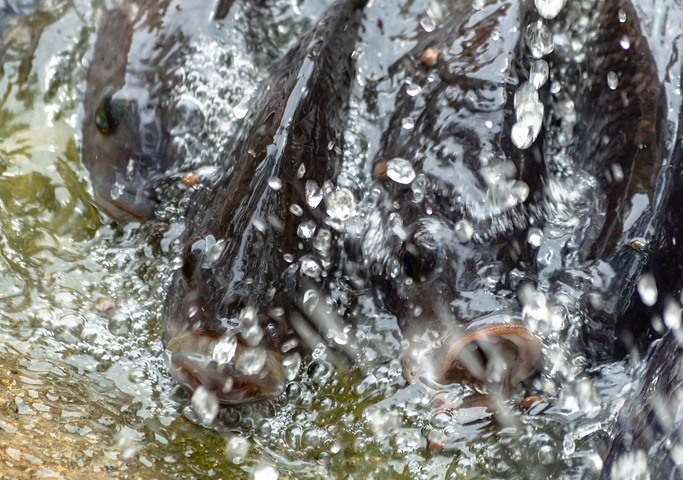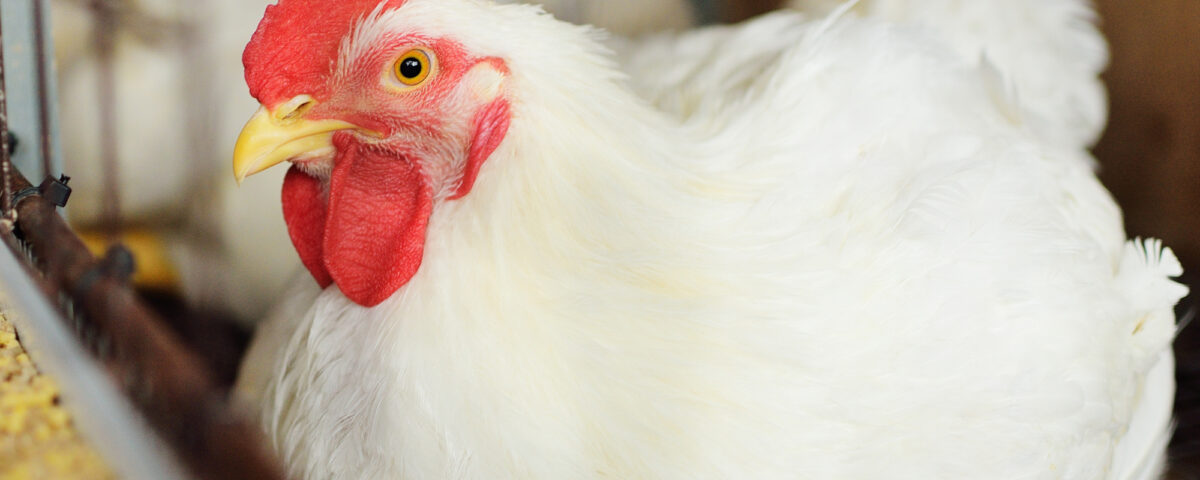
This disease represents an important problem for US poultry producers
- General aspects of necrotic dermatitis
- Prevalence of necrotic dermatitis in the United States
- Clinical signs in birds
- Lack of effective solutions to treat necrotic dermatitis
- Prevention is key
- Conclusions
- Bibliography
1. General aspects of necrotic dermatitis
Necrotic dermatitis, also known as gangrenous dermatitis, is a disease that affects poultry and is caused by opportunistic microorganisms (clostridia and Staphylococcus aureus). These agents take advantage of predisposing factors to produce the disease.
Broilers, layers, breeder hens and turkeys can suffer necrotic dermatitis, which is considered a disease of great importance in the United States since its prevalence and severity have been increasing for the last years [1].
The growing prevalence is related with a decrease in the use of antibiotics, whether because of regulation limitations or the increasing implantation of non-antibiotic (ABF or NAE) and organic production systems.
Other predisposing factors include those related to stress, such as inadequate environmental conditions or management practices, and zinc or biotin deficiencies, which are essential for the integrity of the epithelia.
2. Prevalence of necrotic dermatitis in the United States
Necrotic dermatitis mostly affects broiler chickens and turkeys in the later growing stages and is associated with practices such as litter reutilization and high densities.
It is among the 10 most important diseases for US broiler producers [2]. This fact is related to the high percentage of chickens raised without antibiotics, around 60% nowadays. In these production systems, necrotic dermatitis and other opportunistic disease outbreaks are more likely to happen.
It is also among the top 10 diseases for US turkey producers, even more important than other well-known problems such as coccidia and Salmonella [1], [3], [4].

3. Clinical signs in birds
Necrotic dermatitis produces skin lesions, particularly in the later production stages. These lesions go from broken follicles to the presence of jelly fluid, vesicles, and even necrosis that reaches the subcutaneous and muscle tissues.
Lesions are more often found in thighs, breasts, and the vent area, and are accompanied with a sudden increase in mortality and the rapid decomposition of dead birds.
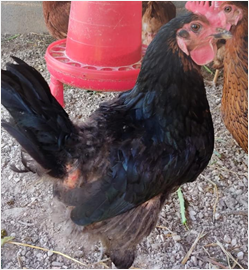
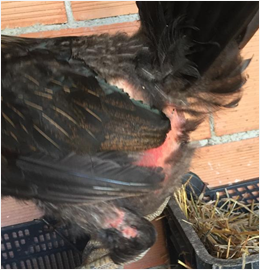
Images 1 and 2. Loss of feathers and reddened skin lesions in the area around the vent.
Subcutaneous lesions are characteristic for necrotic dermatitis. Identifying them helps to reach a presumptive diagnosis. The causal agents can be confirmed in the laboratory via microbial cultures, PCR, immunohistochemistry or antibody tests [5]. Despite this, the general recommendation is to identify the predisposing factors in order to control future outbreaks.
4. Lack of effective solutions to treat necrotic dermatitis
There is not a unique solution to treat necrotic dermatitis. Some antibiotics showed positive effects on mortality, but the increasing development of resistance made them lose efficacy. Besides, farms that usually suffer this disease are into production systems that already limit the use of these drugs, making them an unavailable solution.
Treatment should be based on mitigating the consequences of the infection by:
- The administration of pronutrients, natural molecules that stimulate the organs’ functions, together with vitamins and essential amino acids to recover the general status of birds.
- The administration of natural antimicrobials based on cimenol ring and citric acid in the drinking water to reduce, at least partly, the presence of microorganisms with pathogenic capacity in the gut and feces and maintain gut welfare and nutrient absorption.
It is also recommended to remove dead birds two to three times a day, to apply a sanitary break between production cycles (all in all out) and to change the litter and disinfect the facilities to reduce the loads of microbes in the environment.
Ultimately, since there is not a unique effective solution to treat necrotic dermatitis, the recommendation is to focus on disease prevention by controlling the predisposing factors.
5. Prevention is key
Necrotic dermatitis prevention requires the control of all predisposing factors, which extend to the application of measures to avoid cannibalism and stress, for example by decreasing rearing densities, using balanced diets that include adequate levels of zinc and biotin to maintain skin integrity, decreasing light intensity and improving ventilation.
We also recommend using a combination of three different products developed by Biovet that can reduce the likelihood of suffering and outbreak. In addition, these products will have a positive effect on animal welfare and productive performance:
Immunostimulant pronutrients
Immunostimulant pronutrients are active molecules from plant extracts that stimulate immune cells of the innate and adaptative immune system to maintain their activity at physiological levels. This is essential to prevent stress-related immunosuppression and keep birds ready to eliminate opportunistic pathogens.
Their mechanism of action was described by Biovet’s R&D department and is based on stimulating the expression of certain genes in the DNA of the target cells. A greater expression of these genes allows to produce more specific proteins and to optimize the physiology of immune cells [9], [10].
Moreover, these pronutrients improve vaccine efficacy: when administered the days prior and post vaccination, they help to obtain better protection levels against specific diseases [11], particularly those with immunosuppressive capacity such as avian infectious bronchitis (IBV) or Gumboro disease (IBD), which can act as a primary cause for necrotic dermatitis.
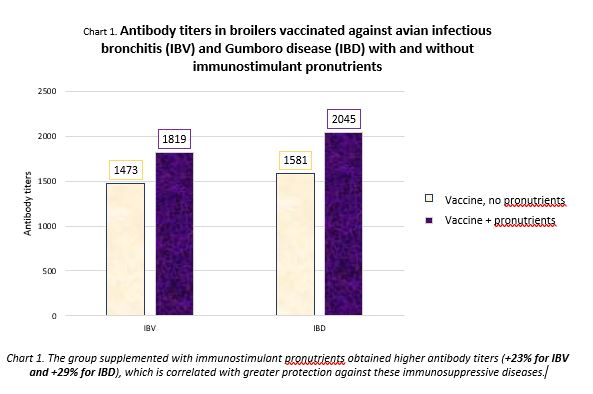
Biotin + intestinal conditioner pronutrients
Biotin is an essential element for skin integrity that is often found in the feed in insufficient amounts because of its price. Biovet S.A. developed a solution, AVAL 9, that contains biotin together with intestinal conditioner pronutrients to optimize the absorption of this compound thanks to improving enterocyte physiology [10].
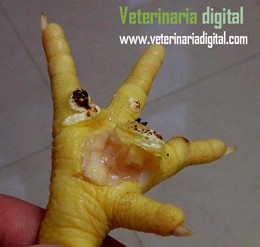
Image 3: Biotin deficiency (vitamin of group B) causes loss of integrity of the epithelium, which can manifest itself with skin or plantar lesions, among others. Source: Veterinaria Digital (atlas of pathology)
Cimenol ring + citric acid
Natural microbicide based on active principles from plant extracts. This combination acts synergistically to cause the death of pathogens thanks to the destabilization of their membrane, producing an osmotic shock [6].
It is a solution developed and patented by Biovet S.A. proved in laboratories and experimental and commercial farms from all around the world.
Despite the effect is limited in the digestive tract, it can maintain the balance of the digestive flora and gut welfare, an essential factor to ensure diet utilization and nutrient absorption, as well as to prevent the overgrowth of pathogens that can produce infections and weaken birds, making them prove to suffer other diseases.
6. Conclusions
Necrotic dermatitis is a relevant problem for the US poultry industry with increasing prevalence and severity. It is a disease caused by opportunistic microorganisms and a multifactorial approach is required to control it.
This approach should be based on avoiding stressful factors, such as suboptimal environmental conditions or management practices, and should include the optimization of the immune system by immunostimulant pronutrients, an optimal skin integrity by the administration of biotin and intestinal conditioner pronutrients that make sure the vitamin is completely absorbed in the gut; and cimenol ring with citric acid to maintain gut welfare and, in consequence, animals’ good health status.
Immunobooster pronutrients are marketed as Alquernat Immuplus*; the combination of pronutrients with biotin as AVAL 9 and the combination of cimenol ring with citric acid as Alquermold Natural*
Alquernat Coneb is recommended as a support treatment and preventative.
These products were developed by Biovet S.A. and are available in premix (to be included in the feed) and liquid (to be included in the water or cereals)
*Certified for organic production
Bibliograhpy
[1] “National Turkey Federation.” [Online]. Available at: https://www.eatturkey.org/about/. [2] AVBP, “American Veterinarians in Broiler Production (AVBP) yearly survey,” 2018. [3] A. Alonzo, “Top 10 turkey industry disease, health challenges,” 2018. [4] S. R. Clark and L. Froebel, “2020 Turkey Industry Annual Report - Current Health And Industry Issues Facing The US Turkey Industry,” 2020. [5] C. D. Gornatti-Churria, M. Crispo, H. L. Shivaprasad, y F. A. Uzal, “Gangrenous dermatitis in chickens and turkeys,” J. Vet. Diagnostic Investig., vol. 30, no. 2, pp. 188–196, 2018. [6] J. Borrell, “Metabolitos fúngicos en los alimentos,” Real Acad. Ciencias Vet. España, 1990. [7] S. Haldar, “Alquermold Natural reduces the risk of Clostridium induced necrotic enteritis in broiler chickens (Summary of results conducted at Agrivet Consultancy P Ltd),” Biovet International Symposium (Oct 2020). Biovet, S.A. [8] S. Haldar, S. Dey, A. Kumar Dhara, D. Diez, T. Chowdhury, C. Domenech, y J. Pie, “T142, Use of AMN to prevent Clostridium perfringens induced necrotic enteritis in broilers,” in ABSTRACTS 2020 International Poultry Scientific Forum, 2020, pp. 44–45. [9] J. Borrell, C. Domenech, N. Martin, y A. Tesouro, “Pronutrients use in poultry nutrition (S11-0224),” in XXV World’s Poultry Congress, 2016, p. 97. [10] J. Borrell, “Uso de pronutrientes de origen natural en veterinaria,” RACVE (Real Acad. Ciencias Vet. España), 2005. [11] D. Díez, C. Domenech, J. P. Orpí, y A. Tesouro, “Use of Alquernat Immuplus (botanical product) to improve the efficacy of vaccination against hemorrhagic enteritis in turkeys,” in Poultry Sicence Association 108th Annual Meeting Abstracts, 2019, p. 241.



